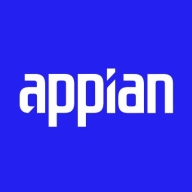

Appian and Control-M compete in the field of business process management and job scheduling, respectively. Appian has a competitive edge with its low-code development, making it accessible and efficient for quick app deployment, while Control-M excels with advanced scheduling and automation features, catering to complex workflows.
Features: Appian provides outstanding low-code capabilities, facilitating rapid development and deployment, and a user-friendly interface catering to non-technical users. It boasts robust process modeling, allowing seamless integration with existing systems. Conversely, Control-M offers exceptional cross-platform job scheduling, advanced workflow management with cross-platform dependency management, and automated error handling, making it ideal for large-scale enterprises.
Room for Improvement: Appian could enhance its offline capabilities, improve customization flexibility, and better integrate with popular enterprise tools like Microsoft and Google services. Its user interface, while improved, still lacks full customization options. Control-M would benefit from improved reporting features, simplified integration with new technologies, and reduced licensing complexity. Enhancing its offline mode and compatibility with cloud services would also be advantageous.
Ease of Deployment and Customer Service: Appian offers versatile deployment options across public, private, and hybrid clouds, appealing to cloud-native environments. Its customer service is praised for being generally responsive, though resolving complex issues more swiftly could further improve support experiences. Control-M provides robust on-premises and hybrid deployment suited for large enterprises but requires improvement in customer service responsiveness and a more streamlined onboarding process.
Pricing and ROI: Appian provides flexible pricing that is more cost-effective compared to competitors like Pega, though potentially pricey for smaller users. Its subscription model supports significant ROI through digital transformation efficiencies. Control-M, while perceived as costly upfront, proves cost-effective for large enterprises given its comprehensive features, although the pricing based on job volume and endpoints can be a barrier for smaller firms.
Appian is very efficient, allowing us to build a lot of applications within a financial year, making it cost-effective.
The main return on investment with Helix Control-M has been a reduction in downtime and minimization of manual interventions, which has improved our operational efficiency.
You can run a million batch jobs or tasks at night when all of your highly skilled people are at home sleeping.
It has reduced the total cost of ownership by 30% to 40%.
Their customer service is responsive, and the team is very prompt for support.
The technical support is generally good.
Appian has a community where I can put my questions.
The technical support is very polite, helpful, and available 24/7.
If something fails at 3 AM in the morning, you need to fix it and get it back up and working really quickly.
They do not always provide timely support.
Initially, without much coding, I can easily handle five thousand records.
Appian is scalable, but it depends on how you build your applications.
It can absorb more workload wherever needed.
As the workload on Control-M increases, its scalability is much higher.
I would rate it a nine out of ten for scalability.
It depends on how it has been designed and how it has been configured.
The downtime is higher compared to AWS.
The stability of the Helix Control-M solution is good.
If there is a very complex process that includes a lot of data transitioning and memory-centric processes, it consumes a lot of memory.
I would like to see more enhancement in the user interface to allow more freedom in designing the sites and pages.
They could provide more documentation and tutorials to make the initial setup easier to understand.
There should be an automation system for developers to set it up more easily and quickly.
What they've done about scheduling, other people are still trying to figure out.
On the pricier side, both Appian and Pega are enterprise-level solutions, placing them on the slightly higher side.
The pricing of Appian is based on the number of users and generally ranges from 70 to 100 USD per user per month.
Pricing is generally affordable, though some features cost a bit more.
The best cell phone will always be more expensive.
The pricing is moderate, not too low or too high compared to other solutions.
The zero-code integration feature is remarkable, allowing for ease of data transfer and workflow enhancement.
It is easy for me to define the process and create configurable workflows.
I can create tables, perform database-related activities, and create multiple tables.
Automation is more advanced, deployment is fast, and version control has been simplified.
The user interface is comprehensive and lets me view all my jobs on one page, monitor everything, and access the job history.
Control-M provides workflow orchestration, including scheduling, deploying, managing, and monitoring workflows.


Appian is a unified low-code platform and solution used by businesses to build enterprise applications and workflows. This product adapts to the needs of clients and the technologies they are already using to combine their data in a single workflow and maximize resources. The platform has four main components through which it transforms the work process for companies of various sizes. They are:
Appian is utilized across a diverse set of industries, including automotive and manufacturing, energy and utilities, education, financial services, telecom and media, transportation, retail, insurance, healthcare, and life sciences. The most frequent use cases of Appian are customer journey, governance, risk and compliance, operational efficiency, supply chain, distributed order management, and environmental, social, and governance (ESG) management.
Appian Features
Appian has various features that allow users to create solutions for their businesses. These features can be separated into a few groups according to function, including automation, low-code application development, and integrations and data. Some of the most frequently used features of Appian include:
Appian Benefits
The benefits of using Appian include:
Reviews from Real Users
A practice leader - digital process automation at a computer software company values Appian highly because the product is easy to develop, low-code, and has a good user interface.
Alan G., an advisory board member at Codecon VR, Appian offers a clear application life cycle, easy to learn documentation, and comes with a fundamentals course.
Control-M is used for enterprise workload automation, orchestrating finance, retail, healthcare, and supply chain processes. It handles batch job scheduling, managed file transfers, cloud integrations, and compliance auditing across on-premises, cloud, and hybrid environments.
Organizations leverage Control-M to efficiently monitor and manage business-critical processes like payroll, HR, SAP, Informatica, and database tasks. It enhances visibility, security, and error resolution. Automating and optimizing workflows in data centers, AWS, Azure, and Google Cloud Platform, Control-M supports diverse technological environments. The platform's robust capabilities make it suitable for effective centralized management of applications and data pipelines, ensuring enhanced collaboration and scalability.
What are Control-M's most important features?Control-M is implemented in industries like finance to handle payroll and HR tasks, in retail for inventory management and supply chain processes, and in healthcare for compliance auditing and patient data processing. Organizations benefit from streamlined workflows and automated processes across on-premises, cloud, and hybrid environments, ensuring efficient and secure operations.
We monitor all Process Automation reviews to prevent fraudulent reviews and keep review quality high. We do not post reviews by company employees or direct competitors. We validate each review for authenticity via cross-reference with LinkedIn, and personal follow-up with the reviewer when necessary.